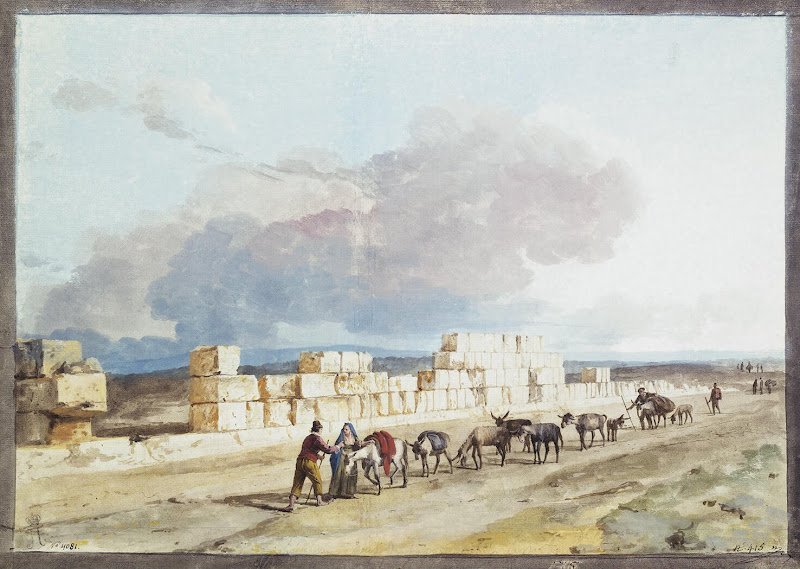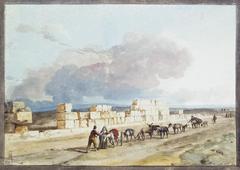
Tas-Silġ Marsaxlokk Malta: Visiting Hours, Tickets, and Historical Significance Guide
Date: 14/06/2025
Introduction
Tas-Silġ, perched atop a limestone hill with panoramic views of Marsaxlokk Bay in southeastern Malta, stands as one of the island’s premier archaeological treasures. This multi-layered sanctuary encapsulates more than 4,000 years of continuous human activity, reflecting Malta’s pivotal role as a crossroads of Mediterranean civilizations. From its origins as a Neolithic temple complex, through its transformation into a Phoenician and Punic sanctuary, Roman religious center, and finally a Byzantine basilica, Tas-Silġ offers a rich narrative of spiritual and cultural evolution (University of Malta; Heritage Malta).
Today, Tas-Silġ is a protected archaeological complex. Access is carefully controlled to preserve the fragile remains, but visitors can arrange guided tours through Heritage Malta to explore its unique historical layers. This guide provides detailed information on visiting hours, ticketing, accessibility, how to get there, and what to expect on your visit to Tas-Silġ.
Table of Contents
- Introduction
- Historical Overview
- Visiting Information
- Site Layout and Main Features
- Nearby Attractions
- Frequently Asked Questions (FAQ)
- Responsible Tourism
- Summary and Recommendations
- Sources
Historical Overview
Prehistoric and Neolithic Beginnings
Tas-Silġ’s earliest occupation dates to the Tarxien Phase of the Maltese Neolithic (c. 3150–2500 BCE), marked by the construction of megalithic temples. Recent excavations, including a significant 2021 discovery, have revealed additional Neolithic structures, suggesting the sanctuary’s boundaries extend further than previously thought (Arkeonews). The site shares architectural features with other megalithic temples such as Ħaġar Qim and Tarxien, including massive limestone blocks, altars, and oracular chambers (University of Malta).
Bronze Age and Settlement Transformation
During the Bronze Age (c. 2500–700 BCE), Tas-Silġ shifted in character, possibly serving as a settlement or communal gathering place rather than a purely religious site. Archaeological finds from this period indicate the development of domestic structures and changing social dynamics (Wikipedia).
Phoenician and Punic Sanctuary
The arrival of the Phoenicians around the 8th century BCE transformed Tas-Silġ into a major sanctuary dedicated to Astarte, later further developed during the Punic era. The sanctuary featured monumental architecture, ritual altars, and a large cistern, serving as a focal point for Mediterranean trade and worship (World Archaeology). The site’s importance is attested by classical sources such as Cicero and Ptolemy (University of Malta).
Roman Adaptation and Early Christianity
After the Roman conquest in 218 BCE, the sanctuary was rededicated to Juno, the Roman counterpart of Astarte. Roman additions included new temples, decorative elements, and ongoing maintenance of the cistern. The sanctuary’s prominence is underscored by references in Cicero’s Verrine Orations (Times of Malta). In the Byzantine period, the site was converted into a Christian basilica, Malta’s earliest known, with evidence of mosaic pavements and a baptistery (SpottingHistory). The basilica served the local community until its eventual abandonment after the Arab conquest in 870 CE.
Modern Archaeological Discoveries
Systematic research began in the 1960s, with significant campaigns by the University of Malta from 1996 to 2005 and ongoing excavations. Recent discoveries, such as the 2021 Neolithic structure, continue to expand our understanding of the site’s extensive occupation (University of Malta).
Visiting Information
Visiting Hours and Booking
Tas-Silġ is not open for general walk-in visits due to ongoing research and the sensitive nature of the remains. Access is strictly by appointment, managed by Heritage Malta.
- Opening Hours: Appointments are typically available Monday to Friday, 9:00 AM–5:00 PM.
- Booking: Contact Heritage Malta’s concierge at +356 21657999 or via the official website to arrange your visit.
Tickets and Admission
- Fees: As of June 2025, admission fees are not fixed and may depend on group size, guide requirements, and tour type. Visits may be free during special open days or Heritage Malta events. Always confirm current rates when booking (Heritage Malta).
- Group Size: Group visits are limited to protect the site.
Accessibility
- Mobility: The site is located on uneven terrain with stone steps and archaeological trenches; it is not fully wheelchair accessible. Visitors with mobility needs should inquire in advance.
- Footwear: Sturdy shoes are recommended due to rocky paths.
Guided Tours
Tas-Silġ’s complexity and limited onsite interpretive signage make guided tours highly recommended. Heritage Malta offers tours led by archaeologists or experts, which can be tailored to specific interests or age groups. Tours are generally conducted in English, with other languages available by prior request (Heritage Malta).
How to Get There
By Public Transport:
- From Valletta, take bus routes 91, 92, or 93 directly to Marsaxlokk. From the village center, it’s about a 15-minute uphill walk or a short taxi ride to the site (Travel Made Me Do It).
- From Marsaskala, bus 119 connects to Marsaxlokk in about 25 minutes.
- The CitySightseeing Malta hop-on hop-off bus (South Malta red line, stop 4) also serves Marsaxlokk (Malta Info Guide).
By Car:
- Follow signs to Żejtun, then Marsaxlokk. Parking is available along the promenade or in a large lot near the bay, but can be busy on Sundays due to the market (Malta Info Guide). Taxis from Valletta or the airport cost around €20 one way.
Facilities and Practical Tips
- Facilities: There are no restrooms, cafés, or shops at Tas-Silġ. The nearest amenities are found in Marsaxlokk village.
- What to Bring: Water, sun protection, a hat, and a camera. Photography is permitted (no flash; drones require permission).
- Safety: Stay on marked paths; do not touch or remove artifacts. Children must be supervised at all times.
Site Layout and Main Features
Archaeological Layers
Tas-Silġ covers approximately 150 by 100 meters, comprising several distinct historical phases:
- Megalithic Temple (Neolithic): Massive limestone blocks, cup-marked slabs, and apsidal chambers.
- Punic Sanctuary: Rectangular sacred enclosure with altars and ritual pits.
- Roman Temple: Podium foundations and column bases, with evidence of decorative stonework.
- Byzantine Basilica: Mosaic floors, baptistery, and reused architectural elements.
Key Structures to See
- Neolithic Megalithic Remains: Upright stones and southern apse, the focal point of prehistoric worship.
- Punic and Roman Altars: Fragments of marble columns and ritual installations.
- Christian Basilica: Mosaic pavements and stone baptismal font.
- Cisterns and Water Channels: Ancient water management systems vital for sanctuary rituals.
Nearby Attractions
- Marsaxlokk Fishing Village: Renowned for its colorful luzzu boats, daily fish market, and waterfront dining (Malta Uncovered).
- St. Peter’s Pool: Popular natural swimming spot on the Delimara Peninsula.
- Fort Delimara: Historic British fort overlooking the bay.
- Church of Our Lady of Tas-Silġ: A modern church near the archaeological site, continuing the area’s spiritual tradition.
For those interested in hiking, the Tas-Silġ Walk from Marsaskala to Marsaxlokk passes the site and other scenic coastal landmarks (Travel Made Me Do It).
Frequently Asked Questions (FAQ)
Q: What are Tas-Silġ’s visiting hours?
A: Visits are strictly by appointment, generally Monday to Friday, 9:00 AM to 5:00 PM. Book through Heritage Malta.
Q: How do I book tickets?
A: Contact Heritage Malta via their official website or phone.
Q: Is the site wheelchair accessible?
A: The terrain is uneven and not fully accessible for wheelchairs; inquire in advance for specific needs.
Q: Are guided tours available?
A: Yes. Guided tours are recommended and can be booked in advance.
Q: Are there restrooms or refreshments on site?
A: No. The nearest amenities are in Marsaxlokk village.
Q: Can I take photographs at Tas-Silġ?
A: Non-flash photography is permitted; drones require prior authorization.
Responsible Tourism
Tas-Silġ is a fragile archaeological site. Visitors are asked to respect all guidelines, stay on marked paths, and avoid disturbing excavation areas. Support ongoing research and conservation by providing feedback or making donations where possible.
Summary and Recommendations
Tas-Silġ stands as a testament to Malta’s enduring archaeological and spiritual legacy. Its multi-period remains offer a rare opportunity to trace over four millennia of cultural evolution in a single location. While access is controlled to preserve the site, visitors who book in advance and join guided tours will find Tas-Silġ an unforgettable highlight of their Maltese journey. Combine your visit with the nearby attractions of Marsaxlokk and the island’s other renowned historical sites for a comprehensive cultural experience.
Stay connected with Heritage Malta for updates on open days, special events, and new discoveries. Download the Audiala app for audio guides and interpretive content to enhance your visit.
Sources
- University of Malta, 2021, Tas-Silġ Malta Research
- Heritage Malta, 2025, Tas-Silġ Archaeological Complex
- Malta Info Guide, 2025, Tas-Silġ Site Information
- Malta Uncovered, 2025, Marsaxlokk and Tas-Silġ Overview
- Arkeonews, 2021, New Neolithic Structure Unearthed at Tas-Silġ
- Times of Malta, 2020, Excavation Reveals Complex Story of Ancient Tas-Silġ Site
- Travel Made Me Do It, 2025, Tas-Silġ Walk Marsaskala to Marsaxlokk
All external links lead to official or scholarly sources for the most accurate and up-to-date information.
